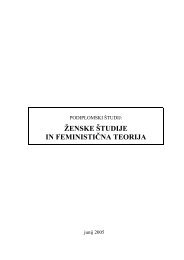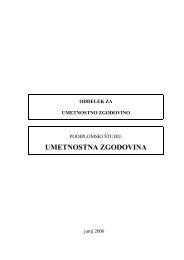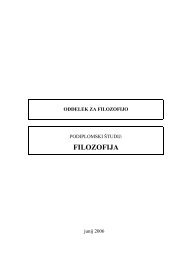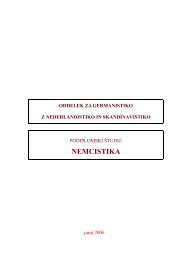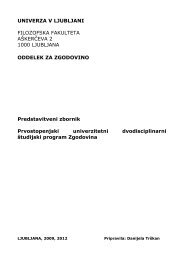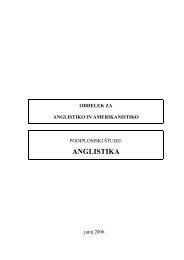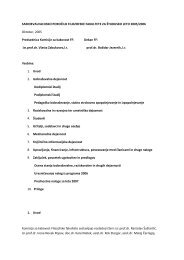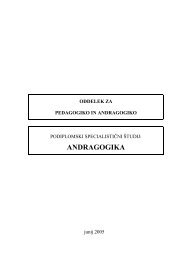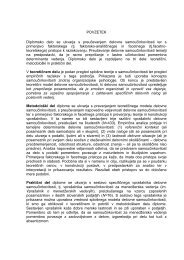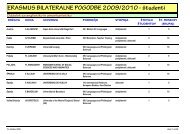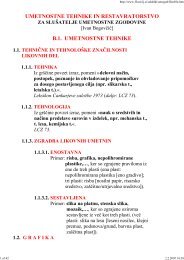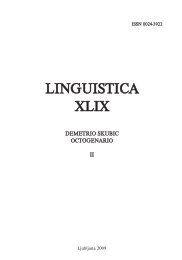B_solo_zgibanke male new_1 - Filozofska fakulteta
B_solo_zgibanke male new_1 - Filozofska fakulteta
B_solo_zgibanke male new_1 - Filozofska fakulteta
Create successful ePaper yourself
Turn your PDF publications into a flip-book with our unique Google optimized e-Paper software.
esponse. Stepping and glissando heads, which can be either descending or<br />
ascending, express emphasis and forcefulness.<br />
4. DiSCOURSe aPPROaCH tO tHe StUDy OF iNtONatiON<br />
the analysis of discourse functions of different prosodic features was carried out by<br />
David Brazil and resulted in an intonation model different from the attitudinal ones<br />
in that it related communicative meanings and values to tones, keys and pitch<br />
sequences valid in all occurrences of these prosodic features (Brazil 1985).<br />
in his work on discourse intonation, Brazil has proposed that certain<br />
relationships exist between tone units which are manifested by means of different<br />
prosodic elements, such as the choice of tone, key and termination. He distinguishes<br />
between two basic, unmarked tones, the fall and the fall-rise. the former is<br />
proclaiming, the latter referring. the term referring means that the fall-rise marks<br />
the matter of the tone unit as part of the shared, already negotiated, common<br />
ground occupied by the participants in an on-going interaction. the fall, in contrast,<br />
presents the matter as <strong>new</strong>, i.e. not yet part of the common ground, hence the term<br />
proclaiming.<br />
in addition to the two unmarked tones, there are also two marked ones, the<br />
proclaiming rise-fall and the referring rise, which are used exclusively to express<br />
dominance in spoken interactions. Dominance can either refer to the social roles<br />
that the speakers exhibit, or, more commonly, to the control of the discourse that is<br />
held by one participant (often the current speaker) who can expect to be allowed to<br />
proceed uninterrupted to the end of the turn. it has to be pointed out that the<br />
dominant speaker can choose between the unmarked (non-dominant) and marked<br />
(dominant) tones. there are, however, types of discourse where the listeners expect<br />
the speakers to behave according to their dominant roles (e.g. doctor-patient,<br />
judge-witness, teacher-pupil interactions).<br />
according to Brazil, the level tone does not exhibit any interactive nature. it is a<br />
tone which occurs normally in “ritualized or pre-coded speech” (Brazil 1995: 244).<br />
in spontaneous speech, the level tone is frequently used when speakers need time to<br />
plan ahead.<br />
Brazil has also proposed that certain relationships exist between tone units.<br />
these are manifested by means of prosodic features which he has called key and<br />
termination. if tones exhibit certain pitch movements, then key and termination<br />
refer to the pitch level of the first (i.e. key) and the last (i.e. termination) pitch<br />
prominent syllables. Both, key and termination, can be realized at three different<br />
pitch levels: high, mid or low.<br />
the communicative value of the high key is to present the matter expressed in<br />
the tone unit as being contrary to the expectations of the hearer. the low key, on the<br />
other hand, presents the matter as something which follows naturally from the<br />
previous matters and is in agreement with the hearer’s expectations. the mid key<br />
expresses no special expectations on the part of the hearer, its function being only<br />
to add one piece of information to the other.<br />
219



